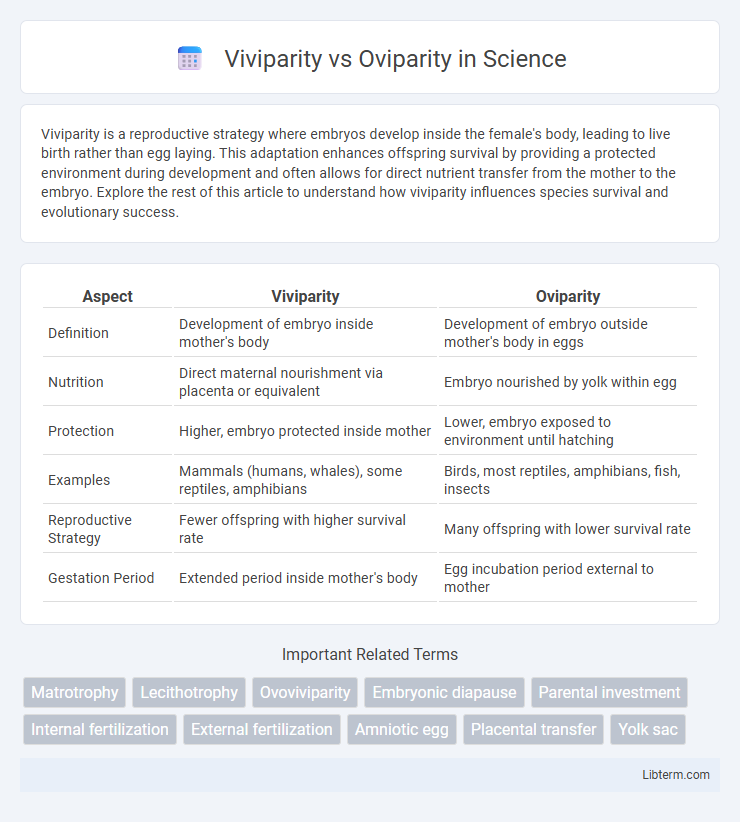Viviparity is a reproductive strategy where embryos develop inside the female's body, leading to live birth rather than egg laying. This adaptation enhances offspring survival by providing a protected environment during development and often allows for direct nutrient transfer from the mother to the embryo. Explore the rest of this article to understand how viviparity influences species survival and evolutionary success.
Table of Comparison
| Aspect | Viviparity | Oviparity |
|---|---|---|
| Definition | Development of embryo inside mother's body | Development of embryo outside mother's body in eggs |
| Nutrition | Direct maternal nourishment via placenta or equivalent | Embryo nourished by yolk within egg |
| Protection | Higher, embryo protected inside mother | Lower, embryo exposed to environment until hatching |
| Examples | Mammals (humans, whales), some reptiles, amphibians | Birds, most reptiles, amphibians, fish, insects |
| Reproductive Strategy | Fewer offspring with higher survival rate | Many offspring with lower survival rate |
| Gestation Period | Extended period inside mother's body | Egg incubation period external to mother |
Introduction to Viviparity and Oviparity
Viviparity and oviparity represent two primary reproductive strategies in the animal kingdom, differing mainly in embryo development and nourishment methods. Viviparous organisms, such as mammals and some reptiles, develop embryos internally with direct maternal nutrient supply, resulting in live birth. Oviparous species, including most birds, amphibians, and many fish, lay eggs with embryos developing externally, relying on yolk as the primary nutrient source.
Defining Viviparity: Live Birth in Animals
Viviparity is a reproductive strategy in animals where embryos develop inside the female's body, resulting in live birth rather than laying eggs. This method enhances offspring survival by providing direct nourishment through structures like the placenta in mammals or specialized tissues in some reptiles and fish. Viviparous species, including most mammals, some reptiles, and a few fishes, exhibit diverse adaptations that support internal embryo development and increase neonatal viability.
Understanding Oviparity: Egg Laying Explained
Oviparity is a reproductive strategy in which animals lay eggs that develop and hatch outside the mother's body, common in birds, reptiles, amphibians, and many fish species. Embryonic development relies on yolk-rich eggs that provide essential nutrients, allowing offspring to mature before hatching in a protected external environment. This method contrasts with viviparity, where young develop inside the mother, but oviparity ensures wider dispersal and can reduce maternal energy investment during gestation.
Evolutionary Origins of Viviparity and Oviparity
Viviparity and oviparity represent two distinct reproductive strategies that have evolved multiple times across vertebrates, with oviparity considered the ancestral state characterized by external egg-laying. Viviparity evolved independently in several lineages, including reptiles, fish, and mammals, through modifications in reproductive anatomy and physiology that enable internal embryo development and live birth. Genetic and fossil evidence suggests that selective pressures such as predation and environmental variability drove the transition from oviparity to viviparity, promoting enhanced offspring survival in diverse ecological contexts.
Physiological Differences Between Viviparous and Oviparous Species
Viviparous species develop embryos inside the mother's body, providing nutrients directly through a placenta or similar structure, resulting in live birth. Oviparous species lay eggs externally, where embryonic development relies on yolk as the primary nutrient source until hatching. These physiological differences influence reproductive strategies, metabolic demands, and parental investment across diverse taxa.
Advantages of Viviparity
Viviparity offers enhanced offspring survival through internal gestation, shielding embryos from environmental hazards and predation. This reproductive strategy allows for better maternal regulation of temperature and nutrient supply, promoting healthier development. Species exhibiting viviparity often experience increased reproductive success in unstable or harsh habitats compared to oviparous counterparts.
Advantages of Oviparity
Oviparity offers the advantage of producing numerous offspring simultaneously, increasing the chances of species survival through quantity. Eggs can be deposited in diverse environments, reducing parental energy investment and allowing parents to focus on foraging and protection. This reproductive strategy also minimizes the risk of internal predation and disease transmission compared to viviparity.
Examples of Viviparous and Oviparous Animals
Viviparous animals such as mammals (humans, dolphins, and kangaroos) give birth to live young after internal fertilization and development. Oviparous animals, including birds (chickens, eagles), reptiles (turtles, snakes), and many fish species, lay eggs that develop and hatch outside the mother's body. Some amphibians like certain frogs exhibit oviparity, while examples of viviparity in reptiles include species like the boa constrictor and some skinks.
Environmental Adaptations and Reproductive Strategies
Viviparity involves embryos developing inside the mother, providing protection in harsh or unstable environments, which enhances offspring survival through direct nutrient transfer. Oviparity relies on external egg-laying, allowing species to produce numerous offspring with less maternal energy investment, suited for stable or resource-rich habitats. These reproductive strategies reflect adaptations to environmental pressures, balancing offspring quantity and quality to maximize reproductive success.
Conclusion: Comparing Viviparity and Oviparity
Viviparity involves internal fertilization with embryo development inside the mother, offering higher offspring survival rates due to protection and direct nourishment, while oviparity relies on external egg laying with environmental factors influencing embryo development and survival. Viviparous species often invest more energy in fewer offspring, enhancing parental care, whereas oviparous species produce numerous eggs, increasing chances of species propagation despite higher mortality. The evolutionary trade-offs between viviparity and oviparity reflect adaptations to ecological niches and reproductive strategies affecting fitness and species survival.
Viviparity Infographic

 libterm.com
libterm.com